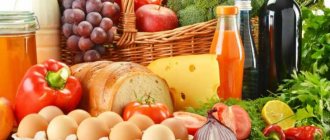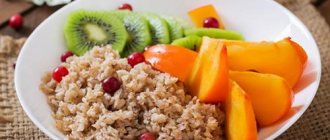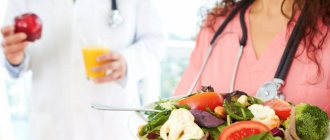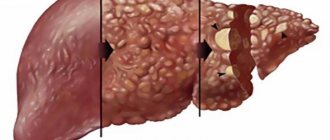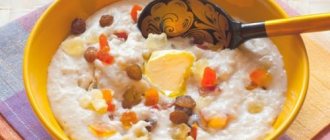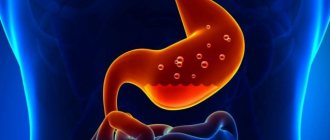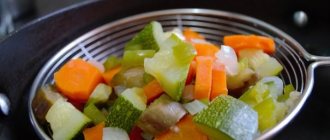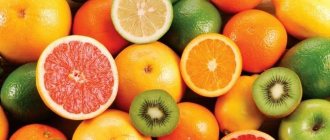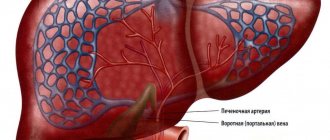Doctors recommend a diet for fatty liver hepatosis to restore the normal functioning of the digestive system and relieve negative symptoms. Comprehensive treatment is indicated, including taking medications and a healthy diet. Excluding prohibited foods from the menu is the key to recovery. To create an optimal diet, it is recommended to consult a nutritionist.
Why do you need a diet?
A fundamental element of treatment is a change in lifestyle, which includes proper nutrition. The patient’s diet should be monitored by the attending physician, who will take into account the physiological characteristics of the body and the stage of development of the disease. A properly selected diet for liver hepatosis has the following positive effects:
- restoration of normal liver function;
- stabilization of fat metabolism in the body;
- lowering blood cholesterol levels;
- normalization of glucose levels;
- stabilization of bile production.
General recommendations
Overeating and starvation are equally dangerous with steatohepatitis. Therefore, despite the need to lose weight, the diet must contain sufficient nutrients.
The diet does not provoke the opposite effect and exacerbation.
Treatment of fatty liver hepatosis is a long process, during which the patient must follow the following basic recommendations from doctors:
- Small meals are recommended 5-6 times a day with short breaks. Portions should be small to prevent overeating and fat gain.
- Doctors recommend following diet number 5.
- The diet for fatty liver excludes hot and cold foods. The optimal food temperature is 20-60 °C.
- You should drink about 2 liters of still water.
- Protein norm - 100 g/day, animal fat - 70 g/day.
- Dishes for hepatosis should not contain purines and cholesterol.
- It is necessary to reduce salt and sugar intake to a minimum.
- You should eat foods that are rich in pectin and fiber: apples, pears, carrots, dill, cilantro.
- If there is a deficiency of micro- and macroelements, dietary supplements should be added to the diet, but only after consulting a doctor.
Why is nutrition important for fatty liver disease?
This pathology develops due to the accumulation of excess fat by liver cells - healthy hepatocytes, first on the outer surface, and then in the internal structures of the organ, are gradually replaced by third-party formations with a loose consistency.
The most important negative factor in the above-described pathological process, as modern medical practice shows, is a poorly balanced diet, which not only increases body weight and creates the preconditions for slowing down metabolic lipid mechanisms, but also seriously affects the liver.
In turn, a strictly followed diet, even in the presence of complications, can significantly improve the condition of the organ , slow down or completely stop the growth of fat deposits, after which the medications used and other methods of conservative therapy will complement the healing process.
https://youtu.be/GPCF5UJ-XUo
What can you eat?
The diet for liver steatosis should be based on boiled, stewed and steamed food. A gentle method of heat treatment reduces the load on the gastrointestinal tract and accelerates the absorption of nutrients. When creating a menu, it is important to take into account possible individual negative reactions to specific ingredients. The table shows the foods you can eat daily:
| Group | Healthy food |
| Soups | Vegetables |
| Buckwheat | |
| Rice | |
| Vermicelli | |
| Dairy | |
| Meat | Chicken |
| Turkey | |
| Beef | |
| Rabbit | |
| By-products | Language |
| Bread | Rye |
| Crackers | |
| Fermented milk products | Low-fat cottage cheese |
| Milk | |
| Low-fat sour cream | |
| Homemade yogurt | |
| Cereals | Buckwheat |
| Rice | |
| Bulgur | |
| Oatmeal | |
| Pasta | Made from durum wheat |
| Spices | Bay leaf |
| Parsley | |
| Dill | |
| Dessert | Honey |
| Marmalade | |
| Paste |
Easily digestible food is a condition without which successful treatment is impossible.
Doctors recommend drinking freshly squeezed juices, wild berry compotes, and jelly with minimal added sugar. Weak black tea is allowed in small quantities - no more than 1-2 cups per day. Hibiscus, a decoction of rose hips and mountain herbs will be more beneficial for the body. You should also drink plain water between meals.
Prohibited Products
The list of prohibited products includes
- fried foods (disturb the digestion process),
- dishes with a large amount of animal fats, purines and carbohydrates (contribute to the development of complications of the disease),
- irritating the gastric mucosa and increasing the production of gastric juice (activate the gastrointestinal tract, provoke excess formation of bile, which increases the load on the diseased liver).
In addition, it is necessary to avoid easily digestible carbohydrates, since they quickly turn into fats and are not stored in the liver as glycogen.
Products that cause increased gas formation and linger in the intestines for a long time, thereby “forcing” the liver to work in vain, should also be excluded.
List of prohibited products
- Coffee, cocoa, carbonated and sweet drinks (Coca-Cola, Pepsi, lemonade), grape juice should be excluded from drinks;
- soups: okroshka, meat, fish and mushroom broths, soups from legumes, spinach, sorrel;
- pasta with mayonnaise, spicy or tomato sauce, with butter;
- offal (liver, heart, tongue), fatty meats and poultry (duck, goose, pork, lamb), sausages, smoked meats, canned meat and fish;
- fish caviar, sushi, fatty fish (trout, sturgeon, beluga, catfish, burbot, eel), salted and smoked fish;
- fresh bread, puff pastry and yeast dough products, fried donuts and pies;
- sharp and salty cheeses, full-fat cottage cheese, sour cream, cream, high-fat milk;
- prohibited vegetables: white cabbage, Brussels sprouts, sorrel, spinach, rhubarb, radish, radishes, turnips, eggplant, garlic and onions (increase the secretion of gastric juice), asparagus, bell pepper, green onions, pickled vegetable snacks, herbs) parsley , dill, fennel, basil) in large quantities;
- raw berries and fruits (raspberries, figs, grapes, cranberries, strawberries, plums, pears, melons, cherries, etc.);
- boiled eggs and dishes with the addition of whole eggs;
- mayonnaise, ketchup, adjika, horseradish, mustard, pepper, vinegar, other spices;
- confectionery products with cream and protein creams, limited sugar, chocolate.
What can't you eat?
In order not to increase negative symptoms and prevent complications, nutrition for fatty liver should exclude the foods presented in the table:
| Category | Junk food |
| Soups | Okroshka |
| Meat | |
| Fish | |
| Mushroom | |
| Vegetables | Spinach |
| Sorrel | |
| Cabbage | |
| Radish | |
| Rhubarb | |
| Eggplant | |
| Garlic | |
| Asparagus | |
| Pepper | |
| By-products | Fatty liver |
| Heart | |
| Kidneys | |
| Meat | Goose |
| Pork | |
| Mutton | |
| Meat products | Sausages |
| Canned food | |
| Smoked meats | |
| Fish | Trout |
| Acne | |
| Sturgeon | |
| Sushi | |
| Berries and fruits | Raspberries |
| Blackberry | |
| Plum | |
| Cherry | |
| Grape | |
| Figs | |
| Cranberry | |
| Melon | |
| Flour products | Fresh bread |
| Puff pastry and yeast dough | |
| Fried pies | |
| Fermented milk products | Spicy and salty cheeses |
| High fat foods | |
| Seasonings | Horseradish |
| Adjika | |
| Pepper | |
| Vinegar | |
| Pickles | Sauerkraut |
| cucumbers | |
| Tomatoes |
The diet also includes avoiding periodic intake of junk food.
You cannot eat fast food, fatty and spicy foods. Mayonnaise, ketchup and other store-bought sauces should be completely excluded from your diet. Dried herbs can be used as an alternative. Liver steatosis excludes the consumption of coffee, cocoa, and sweet carbonated drinks. You should not drink grape juices, as the risk of additional stress on the pancreas increases. Alcohol is prohibited, including low-alcohol drinks: beer, wine.
Treatment table 5
The optimal diet for fatty hepatosis was developed by USSR nutritionist Manuil Pevzner. An effective technique is based on maintaining a balance of nutrients. The table shows the optimal ratio:
| Nutrients | Norm, g/day. |
| Squirrels | 110 |
| Fats | 80 |
| Carbohydrates | 300 |
| Salt | 10 |
Control of protein and fat intake is required to stop the process of fatty infiltration of the liver.
In case of steatohepatosis, it is necessary to avoid products rich in essential oils and active substances, which cause excessive secretion of the gastrointestinal tract. Table 5 also helps lower cholesterol levels by eliminating fried and fatty foods. Plain water can be replaced with fruit drink or rosehip decoction, but sugar should not be added to drinks.
Sample menu
This diet will help you avoid unpleasant signs of illness.
An example of a combination of what you can eat for every day:
- First breakfast: cottage cheese casserole;
- rosehip decoction.
- homemade yogurt;
- buckwheat soup;
- kefir;
- rice;
- a glass of fermented baked milk.
Sample menu for the week
Doctors recommend eating vegetable soups for breakfast, eating porridge for lunch, and eating stewed or baked dishes in the evening. This choice may seem strange, since everyone believes that it is necessary to have a hearty breakfast. However, eating cereal for lunch will give you an energy boost. If you have lunch late, then you should use a traditional diet and start the day with high-calorie dishes.
Example of a traditional menu:
- Monday:
- start the day with rice porridge with water or low-fat milk (you can dilute regular milk with water) and herbal tea;
- for second breakfast, make a fruit salad from allowed fruits, it should be based on an apple;
- for lunch, prepare a vegetable puree soup, make a combined puree of pumpkin, potatoes and carrots, serve it with steamed cutlets, wash it all down with berry jelly;
- For an afternoon snack, make a cottage cheese casserole from low-fat cottage cheese;
- end the day with rice porridge with fish, weak tea, and drink kefir at night.
- Tuesday:
- have breakfast with milk semolina porridge and weak tea;
- for second breakfast, eat oatmeal cookies or biscuits with rosehip infusion;
- the main course of lunch is vegetarian borscht; for the second course, eat vegetable stew and meat soufflé, wash it all down with unsweetened compote;
- afternoon snack – low-fat cottage cheese with sour cream;
- end the day with a casserole of vegetables and fish with jelly, drink kefir before bed.
- Wednesday:
- morning: steamed protein omelet and tea with milk;
- second breakfast: dietary vinaigrette;
- lunch: vegetable cream soup with chicken, buckwheat porridge with stewed vegetables, compote;
- for an afternoon snack, treat yourself to meringues with fruit tea or compote;
- dinner: casserole of noodles and meat with weak tea, at night - kefir or fermented baked milk.
- Thursday:
- start your morning with buckwheat porridge with a small slice of Adyghe cheese, drink herbal tea;
- fruit and berry mousse and compote are a good choice for second breakfast;
- dine on sour cabbage soup, vegetable soufflé and fish quenelles, wash it all down with compote or rose hip decoction;
- For an afternoon snack, eat lazy dumplings with sour cream, wash down with weak tea;
- For dinner, eat dietary pilaf with rosehip infusion, and drink yogurt before bed.
- Friday:
- start the day with oatmeal with dried fruits and weak tea;
- For second breakfast, eat a rich cracker and drink tea;
- for lunch, make vegetable puree soup with rice, steamed fish cutlets with mashed potatoes, herbal tea;
- for an afternoon snack, eat a steamed protein omelet with fruit juice;
- dine on diet cabbage rolls with homemade rye noodles, wash them down with weak tea, and drink a glass of buttermilk at night.
- Saturday:
- breakfast: cottage cheese with sour cream, jelly;
- second meal – rice and pumpkin casserole, weak tea;
- lunch: carrot cream soup, boiled fish with oatmeal on water, jelly;
- biscuits and herbal tea - for an afternoon snack;
- dinner: stewed rabbit with vegetables, jelly, kefir at night.
- Sunday:
- breakfast: oatmeal with fruit, tea;
- second breakfast – smoothie;
- lunch: fish soup and vegetable salad, jelly;
- cottage cheese casserole for an afternoon snack;
- dinner: chicken wings in a sleeve without oil, baked potatoes, tea, and before bed, fermented baked milk.
The recommendations listed above give a false impression of the calorie content of the diet.
This is a balanced diet that does not contain excess calories. Weight loss can occur by giving up flour products and reducing sweets. https://youtube.com/watch?v=Uhs6FRYJgY4
Recommended Recipes
If a patient is diagnosed with fatty hepatosis, then one should be especially careful when choosing ingredients. For breakfast you can prepare a vegetable omelet:
- Boil diced zucchini and green peas for 10-15 minutes.
- Products are filled with egg - 1 pc. You can add 1-2 more whites and beat.
- The mixture is poured into a sealed bag and placed in boiling water for 5 minutes.
When creating a menu for the week, a recipe for lean borscht will come in handy:
- Beets, carrots, and potatoes are cut into strips.
- The cabbage is peeled from the top leaves and cut thinly.
- The skins are removed from the tomatoes and the tomatoes are cut into cubes.
- Place cabbage and potatoes in boiling water and cook over low heat.
- Carrots are fried with a minimum of sunflower oil.
- Add part of the beets to the frying pan and simmer for 10-15 minutes, and the second half is doused with boiling water and infused for 15-20 minutes.
- In the pan for another 20 minutes. vegetables are stewed.
- All ingredients are mixed in a saucepan and cooked over maximum heat.
- Borscht is infused for 10-15 minutes.
Fatty liver may not be the only disease, and therefore, when choosing recipes, possible individual negative reactions to the ingredients of the dish should be taken into account. If a patient experiences an increase in symptoms or allergies after eating certain foods, they should immediately consult their doctor and change their diet.

